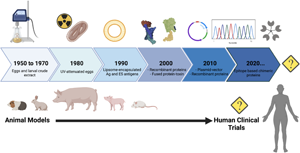Crossref Citations
This article has been cited by the following publications. This list is generated based on data provided by
Crossref.
Papaiakovou, Marina
Littlewood, D. Timothy J.
Doyle, Stephen R.
Gasser, Robin B.
and
Cantacessi, Cinzia
2022.
Worms and bugs of the gut: the search for diagnostic signatures using barcoding, and metagenomics–metabolomics.
Parasites & Vectors,
Vol. 15,
Issue. 1,
Nath Mukhopadhyay, Narendra
2023.
Roundworms - A Survey From Past to Present.
Castro, Joseane C.
Magalhães, Luisa MD.
Almeida, Raquel M.
Oliveira, Fabricio MS.
Nogueira, Denise S.
Gazzinelli-Guimarães, Ana Clara
Kraemer, Lucas
Barbosa, Fernando S.
Santos, Flavianne Vieira
Minighin, Elaine C.
Bueno, Lilian L.
Bartholomeu, Daniella C.
Labanca, Renata A.
and
Fujiwara, Ricardo T.
2023.
Bioaccessibility and oral immunization efficacy of a chimeric protein vaccine against Ascaris suum.
Microbes and Infection,
Vol. 25,
Issue. 3,
p.
105042.
Evangelista, Francisco M. D.
van Vliet, Arnoud H. M.
Lawton, Scott P.
and
Betson, Martha
2023.
In silico design of a polypeptide as a vaccine candidate against ascariasis.
Scientific Reports,
Vol. 13,
Issue. 1,
Afifi, Mohammed A.
Al-Rabia, Mohammed W.
and
Fallatah, Deema I.
2024.
Animal Models In Experimental Medicine.
p.
20.
Soleymani, Nooshinmehr
Sadr, Soheil
Santucciu, Cinzia
Dianaty, Shiva
Lotfalizadeh, Narges
Hajjafari, Ashkan
Heshmati, Fatemeh
and
Borji, Hassan
2024.
Unveiling Novel Insights in Helminth Proteomics: Advancements, Applications, and Implications for Parasitology and Beyond.
Biologics,
Vol. 4,
Issue. 3,
p.
314.
Bhagwat, Aniruddha D.
Patil, Rashmi
Makan, Apoorva
Vaze, Dhananjay
and
Jadhav, Pranav
2024.
Helminthic intestinal perforations in children: our experience.
Journal of Parasitic Diseases,
Wolstenholme, Adrian J.
Andersen, Erik C.
Choudhary, Shivani
Ebner, Friederike
Hartmann, Susanne
Holden-Dye, Lindy
Kashyap, Sudhanva S.
Krücken, Jürgen
Martin, Richard J.
Midha, Ankur
Nejsum, Peter
Neveu, Cedric
Robertson, Alan P.
von Samson-Himmelstjerna, Georg
Walker, Robert
Wang, Jianbin
Whitehead, Bradley J.
and
Williams, Paul D.E.
2024.
Vol. 123,
Issue. ,
p.
51.
Cardoso, Mariana Ribeiro Rodero
Sameshima, Yoshino Tamaki
Del Campo Braojos Braga, Fernanda
Gual, Fabiana
Fernandes-Ferreira, Rafael
and
Souza, Antonio Soares
2024.
Multimodality imaging of pediatric ascariasis.
Pediatric Radiology,
Vol. 55,
Issue. 1,
p.
128.
Wong, Li Ping
Lee, Hai Yen
Alias, Haridah
Lachyan, Abhishek
Nguyen, Di Khanh
Seheli, Farhana Nishat
Ahmed, Jamil
Hu, Zhijian
and
Lin, Yulan
2025.
Knowledge, experience, and willingness to vaccinate against intestinal parasitic infections: A multi-country study in Asia.
Journal of Infection and Public Health,
Vol. 18,
Issue. 4,
p.
102689.
Vanhove, Maarten P. M.
Koblmüller, Stephan
Fernandes, Jorge M. O.
Hahn, Christoph
Plusquin, Michelle
and
Kmentová, Nikol
2025.
Cichlid fishes are promising underutilized models to investigate helminth-host-microbiome interactions.
Frontiers in Immunology,
Vol. 16,
Issue. ,




